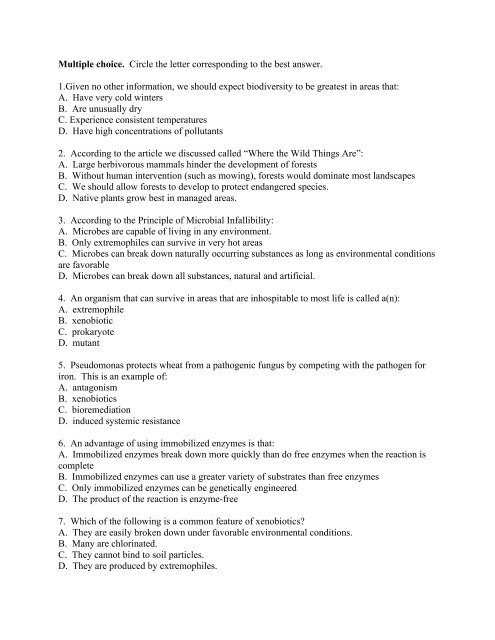Matching. Write the letter that corresponds to the best answer. ____ ...
Matching. Write the letter that corresponds to the best answer. ____ ...
Matching. Write the letter that corresponds to the best answer. ____ ...
Create successful ePaper yourself
Turn your PDF publications into a flip-book with our unique Google optimized e-Paper software.
Multiple choice. Circle <strong>the</strong> <strong>letter</strong> corresponding <strong>to</strong> <strong>the</strong> <strong>best</strong> <strong>answer</strong>.<br />
1.Given no o<strong>the</strong>r information, we should expect biodiversity <strong>to</strong> be greatest in areas <strong>that</strong>:<br />
A. Have very cold winters<br />
B. Are unusually dry<br />
C. Experience consistent temperatures<br />
D. Have high concentrations of pollutants<br />
2. According <strong>to</strong> <strong>the</strong> article we discussed called “Where <strong>the</strong> Wild Things Are”:<br />
A. Large herbivorous mammals hinder <strong>the</strong> development of forests<br />
B. Without human intervention (such as mowing), forests would dominate most landscapes<br />
C. We should allow forests <strong>to</strong> develop <strong>to</strong> protect endangered species.<br />
D. Native plants grow <strong>best</strong> in managed areas.<br />
3. According <strong>to</strong> <strong>the</strong> Principle of Microbial Infallibility:<br />
A. Microbes are capable of living in any environment.<br />
B. Only extremophiles can survive in very hot areas<br />
C. Microbes can break down naturally occurring substances as long as environmental conditions<br />
are favorable<br />
D. Microbes can break down all substances, natural and artificial.<br />
4. An organism <strong>that</strong> can survive in areas <strong>that</strong> are inhospitable <strong>to</strong> most life is called a(n):<br />
A. extremophile<br />
B. xenobiotic<br />
C. prokaryote<br />
D. mutant<br />
5. Pseudomonas protects wheat from a pathogenic fungus by competing with <strong>the</strong> pathogen for<br />
iron. This is an example of:<br />
A. antagonism<br />
B. xenobiotics<br />
C. bioremediation<br />
D. induced systemic resistance<br />
6. An advantage of using immobilized enzymes is <strong>that</strong>:<br />
A. Immobilized enzymes break down more quickly than do free enzymes when <strong>the</strong> reaction is<br />
complete<br />
B. Immobilized enzymes can use a greater variety of substrates than free enzymes<br />
C. Only immobilized enzymes can be genetically engineered<br />
D. The product of <strong>the</strong> reaction is enzyme-free<br />
7. Which of <strong>the</strong> following is a common feature of xenobiotics?<br />
A. They are easily broken down under favorable environmental conditions.<br />
B. Many are chlorinated.<br />
C. They cannot bind <strong>to</strong> soil particles.<br />
D. They are produced by extremophiles.

















